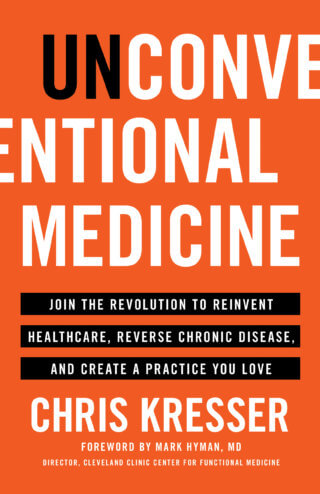
- One in two Americans now suffers from chronic disease, and one in four has multiple chronic conditions.
- Chronic disease is responsible for seven of ten deaths each year.
- The rate of chronic disease in kids more than doubled between 1994 and 2006.
- 84 percent of the $3.8 trillion we spend on healthcare in the United States each year goes toward treating chronic disease.
How would you rate conventional medicine’s approach to chronic disease?As a case in point, consider the Tsimané, a subsistence farmer and hunter–gatherer population in Bolivia. They eat meat, fish, fruit, vegetables, nuts and seeds, and some starchy plants. They walk an average of 17,000 steps (~8 miles) a day. They spend a lot of time outdoors, get plenty of sleep, and aren’t exposed to a lot of artificial light at night. In a recent study, researchers found that the prevalence of atherosclerosis was 80 percent lower in the Tsimané than in the United States. Nearly nine in ten Tsimané adults between the ages of 40 and 94 had clean arteries and faced virtually no risk of cardiovascular disease. What’s more, this study included elderly people—it was estimated that the average 80-year-old in the Tsimané group had the same vascular age as an American in his mid-50s. (1)
The consequences of chronic disease are profound
Chronic disease is not a small problem. It’s an insidious, slow-motion plague that is exploding through Western populations, shortening our lifespan, destroying our quality of life, bankrupting our country, and threatening the very survival of our species. The consequences for patients are painfully obvious. Consider the following:- Two-thirds of Americans are overweight, and one in three is obese. According to a recent report, half of Americans will be obese by 2030. (2)
- The prevalence of autism spectrum disorder (ASD) more than doubled from 2000 to 2010—and not just because of increased rates of detection. (3)
- Rates of autoimmune disease have doubled or tripled over the past 50 years (depending on which estimate you look at) and are expected to continue to rise sharply.
- Over half of adults take prescription drugs, and 40 percent of the elderly take more than five medications. (4)
- 90 percent of doctors feel medicine is on the wrong track.
- 83 percent of doctors have thought of quitting medicine.
- Half of doctors describe themselves as either often or always feeling “burned out.”
- In inflation-adjusted dollars, the average physician earns the same wage as she did in 1970 but sees twice the number of patients. (5, 6)
- Annual healthcare expenditures in the United States hit $3.8 trillion in 2013—more than $10,000 for every man, woman, and child and about 24 percent of our GDP.
- If healthcare spending continues to rise at its current pace, the United States will be insolvent (bankrupt) by 2035.
- Globally, spending on chronic disease is expected to reach $47 trillion by 2030, an amount greater than the GDP of the six largest economies in the world.
Two reasons conventional medicine has failed to address chronic disease
There are many reasons conventional medicine has failed to address the chronic disease epidemic, but I’d like to focus on what I believe are the two most fundamental issues. #1: The wrong medical paradigm Conventional medicine evolved during a time when acute, infectious diseases were the leading causes of death. Most other problems that brought people to the doctor were also acute, like appendicitis or gall bladder attack. Treatment in these cases was relatively simple: the patient developed pneumonia, went to see the doctor, received an antibiotic (once they were invented), and either got well or died. One problem, one doctor, one treatment. Today things aren’t quite so simple. The average patient sees the doctor not for an acute problem, but for a chronic one (or in many cases, more than one chronic issue). Chronic diseases are difficult to manage, expensive to treat, require more than one doctor, and typically last a lifetime. They don’t lend themselves to the “one problem, one doctor, one treatment” approach of the past. Unfortunately, the application of the conventional medical paradigm to the modern problem of chronic disease has led to a system that emphasizes suppressing symptoms with drugs (and sometimes surgery), rather than addressing the underlying cause of the problem. For example, if you go to the doctor and find out you have high cholesterol and/or high blood pressure, you’ll be given a drug to lower them—and expected to take that drug for the rest of your life. There is rarely any serious investigation into why your cholesterol or blood pressure is high in the first place. If we consider health and disease on a spectrum, where perfect health is on the left and death is on the right, conventional medicine is focused on intervening at the far right of the spectrum. If I get hit by a bus, I definitely want to go to the hospital! Conventional medicine is also embracing new technologies to do some amazing things, like restoring sight to the blind, re-attaching limbs, and potentially fighting cancer with nanorobots. However, these approaches are not the best way to prevent and reverse chronic disease. Recent statistics suggest that more than 85 percent of chronic disease is caused by environmental factors like diet, behavior, environmental toxins, and lifestyle. (7) More specifically, chronic disease is the direct result of a mismatch between our genes and biology on the one hand and the modern environment on the other. I summarized the research supporting this argument in my first book, The Paleo Cure, and there are numerous examples everywhere we look. For instance, in 1980 only 1 percent of the Chinese population had diabetes. In just one generation, the incidence of diabetes rose by an astounding 1,160 percent! (8) What happened? Was there some kind of massive gene mutation in Chinese people over the past 30 years that caused an outbreak of diabetes? Of course not. Genetic changes take a lot longer than that to occur. Instead, during this period the Chinese shifted from a more traditional diet to a more industrialized, processed diet. The takeaway is clear: if we want to prevent and reverse chronic disease, we need a medical paradigm that:- Recognizes the mismatch between our genes and our behavior and environment as the primary driver of chronic disease; and
- Focuses on preventing and reversing the underlying causes of disease, rather than just suppressing symptoms
- Make possible and encourage longer visits with with patients, with more detailed intake and history and time for discussion and support. Ten- to 12-minute visits may be fine for prescribing drugs for symptoms, but they fall hopelessly short for actually addressing the cause of those symptoms.
- Emphasize collaborative care, where the doctor works with the patient as a partner, rather than in the “expert” model that characterizes our current system. The patient also has access to a care team that includes nurse practitioners/physician assistants, nutritionists, health coaches, and other allied providers to provide another layer of care and more support between appointments.
- Be both high-tech and high-touch, utilizing current technology and practices to streamline and automate cumbersome administrative processes and reduce overhead, both of which free up more time for practitioners to provide quality care to patients.
 The book will go into more depth on why conventional medicine has failed to address the chronic disease epidemic. But more importantly, it outlines a solution that has the potential not only to prevent and reverse chronic disease, but also to reinvent the healthcare system in a way that satisfies the needs of both clinicians/practitioners and patients. Although the book is primarily written for those currently working or considering working in healthcare, it’s also intended for people in the general population who are interested in functional medicine, ancestral health (i.e., “genetically aligned, species-appropriate diet and lifestyle”), innovation, and even revolution in healthcare and playing some role—however small—in helping to co-create the future of medicine. We don’t have a firm release date yet, but the current plan is for a late-August or early-September launch. I’m really excited about it and I hope you are too! Now I’d like to hear from you. How would you rate conventional medicine’s approach to chronic disease? Have you had trouble finding the support you need for a chronic illness within the conventional paradigm? If you’re a practitioner working within this model, how has it served and not served you and your patients? Let me know in the comments section!
The book will go into more depth on why conventional medicine has failed to address the chronic disease epidemic. But more importantly, it outlines a solution that has the potential not only to prevent and reverse chronic disease, but also to reinvent the healthcare system in a way that satisfies the needs of both clinicians/practitioners and patients. Although the book is primarily written for those currently working or considering working in healthcare, it’s also intended for people in the general population who are interested in functional medicine, ancestral health (i.e., “genetically aligned, species-appropriate diet and lifestyle”), innovation, and even revolution in healthcare and playing some role—however small—in helping to co-create the future of medicine. We don’t have a firm release date yet, but the current plan is for a late-August or early-September launch. I’m really excited about it and I hope you are too! Now I’d like to hear from you. How would you rate conventional medicine’s approach to chronic disease? Have you had trouble finding the support you need for a chronic illness within the conventional paradigm? If you’re a practitioner working within this model, how has it served and not served you and your patients? Let me know in the comments section!from Chris Kresser https://chriskresser.com/two-reasons-conventional-medicine-will-never-solve-chronic-disease/
via Holistic Clients
No comments:
Post a Comment